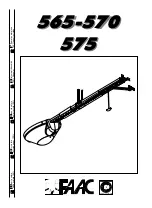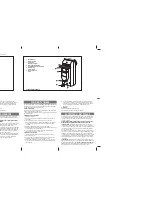
4 Section High Strutting Schedule
Section Type
Type Of Strut
Location On Section
2”
3”
Intermediate II
(1) Long
Top Of Section
Intermediate I
N/A
(1) Long
5 Section High Strutting Schedule
Section Type
Type Of Strut
Location On Section
2”
3”
Intermediate III
(1) Long
Top Of Section
Intermediate II
(1) Long
Intermediate I
N/A
(1) Long
6 Section High Strutting Schedule
Section Type
Type Of Strut
Location On Section
2”
3”
Intermediate IV
(1) Long
Top Of Section
Intermediate III
(1) Long
Intermediate II
(1) Long
Intermediate I
N/A
(1) Long
7 Section High Strutting Schedule
Section Type
Type Of Strut
Location On Section
2”
3”
Intermediate V
(1) Long
Top Of Section
Intermediate IV
(1) Long
Intermediate III
(1) Long
Intermediate II
(1) Long
Intermediate I
N/A
(1) Long
8 Section High Strutting Schedule
Section Type
Type Of Strut
Location On Section
2”
3”
Intermediate VI
(1) Long
Top Of Section
Intermediate V
(1) Long
Intermediate IV
(1) Long
Intermediate III
(1) Long
Intermediate II
(1) Long
Intermediate I
N/A
(1) Long
NOTE:
Center hinge(s) use #1 graduated end hinges at each pre-drilled or vertical stile loca-
tion. The pre-drilled locations are located at the top rails on the inside of the section surface.
NOTE:
Some struts also may or may not have holes in them. If they don’t, then prior to
installing the strut and hinge to the section surface, you may have to drill a 3/16” hole for the
appropriate fastener on one or both sides of the strut legs.
Place the Intermediate I section face down on a couple of sawhorses or flat clean/ smooth
surface. Using the appropriate graduated end hinges for the ends and depending on the
width of your door, enough center hinge(s) for each pre-drilled hole location(s). Starting at the
upper left hand corner of the Intermediate section. Position the lower hinge leaf of the appro-
priate graduated end hinge onto the upper corner of the Intermediate section. Align the slots
of the lower hinge leaf with the pre-drilled holes in the Intermediate section. If applicable, lay
a long strut over the lower hinge leaf and over the top rail of the Intermediate section. Center
the long strut from side to side.
FOR GRADUATED END HINGES WITHOUT A LONG STRUT:
Attach the upper slot of the
graduated end hinge to the Intermediate section using (1) 1/4” - 20 x 2-1/2” carriage bolt
and (1) 1/4” - 20 flange hex nut. Secure the lower hole of the graduated end hinge to the
Intermediate section using (1) 1/4” - 20 x 2-1/2” carriage bolt and (1) 1/4” - 20 flange hex
nut. Repeat for other side.
IF YOU HAVE DOUBLE GRADUATED END HINGES WITHOUT A LONG STRUT:
Position the
second graduated end hinge next to the first (single) graduated end hinge. Using the second
graduated end hinge as a template, drill pilot holes, 1” deep into the bottom section using a
1/8” drill bit.
IMPORTANT:
BE EXTREMELY CAREFUL NOT TO DRILL THRU THE SECTION. ONLY DRILL 1”
DEEP.
Secure the graduated end hinge to the Intermediate section using (2) 1/4” - 14 x 1” lag
screws. Repeat for other side.
FOR GRADUATED END HINGES WITH A LONG STRUT:
Attach the upper leg of the strut, (1)
strut clip to the upper slot of the graduated end hinge to the Intermediate section using (1)
1/4” - 20 x 2-1/2” carriage bolt and (1) 1/4” - 20 flange hex nut. Secure the lower leg of the
strut, (1) strut clip to the lower hole of the graduated end hinge to the Intermediate section
using (1) 1/4” - 20 x 2-1/2” carriage bolt and (1) 1/4” - 20 flange hex nut. Repeat for other
side.
IF YOU HAVE DOUBLE GRADUATED END HINGES WITH A LONG STRUT:
Position the
second graduated end hinge next to the first (single) graduated end hinge. Using the second
graduated end hinge as a template, drill pilot holes, 1” deep into the bottom section using a
1/8” drill bit.
IMPORTANT:
BE EXTREMELY CAREFUL NOT TO DRILL THRU THE SECTION. ONLY DRILL 1”
DEEP.
Secure the strut and the graduated end hinge to the Intermediate section using (2) 1/4” - 14
x 1” lag screws. Repeat for other side.
FOR CENTER HINGES WITHOUT A LONG STRUT:
Attach the upper slot of the center hinge
to the Intermediate section using (1) 1/4” - 20 x 2-1/2” carriage bolt and (1) 1/4” - 20 flange
hex nut. Secure the lower hole of the center hinge to the Intermediate section using (1) 1/4” -
20 x 2-1/2” carriage bolt and (1) 1/4” - 20 flange hex nut. Repeat for other center hinge(s).
FOR CENTER HINGES WITH A LONG STRUT:
Attach the upper leg of the strut, (1) strut clip
to the upper slot of the center hinge to the Intermediate section using (1) 1/4” - 20 x 2-1/2”
carriage bolt and (1) 1/4” - 20 flange hex nut. Secure the lower leg of the strut, (1) strut clip
to the lower hole of the center hinge to the Intermediate section using (1) 1/4” - 20 x 2-1/2”
carriage bolt and (1) 1/4” - 20 flange hex nut. Repeat for other center hinge(s).
NOTE:
If you don’t have half center hinges, then skip this part of the step. Refer to Package
Contents / Breakdown Of Parts, to determine if you have half center hinges.
Using a tape measure, position the half center hinges equally spaced in between the center
hinges and the graduated end hinges. Position the holes of the lower hinge leaf at the top
rail of the Intermediate section. Using the half center hinge as a template, drill pilot holes, 1”
deep into the Intermediate section with a 1/8” drill bit (if needed).
IMPORTANT:
BE EXTREMELY CAREFUL NOT TO DRILL THRU THE SECTION. ONLY DRILL 1”
DEEP.
Attach the lower hinge leaf of the center hinge to the Intermediate section using (2) 1/4” - 14
x 1” lag screws. Repeat for other half center hinge(s).
If you have single graduated end hinges, insert a short stem track roller / short stem tandem
track roller (if included) into the hinge tube on each side.
If you have double graduated end hinges, insert a long stem track roller / short stem tandem
track roller (if included) into the hinge tubes on each side.
IMPORTANT:
WHEN PLACING TRACK ROLLERS / TANDEM TRACK ROLLER (IF INCLUDED)
INTO GRADUATED END HINGES NUMBER 2 AND HIGHER, THE TRACK ROLLER / TANDEM
TRACK ROLLER (IF INCLUDED) GOES INTO TUBE FURTHEST AWAY FROM SECTION.
If applicable, repeat the same process for the other Intermediate sections, except for the top
section.
Attaching Top Fixtures And Strut To Top Sec-
tion
7
NOTE:
Refer to door section identification, located in the pre-installation section of this
manual to determine what size section you need to use as your top section. Measure your
section to make sure it is the correct height as indicated on the chart.
Place the top section face down on a couple of sawhorses or flat clean/ smooth surface.
Lay a
SHORT STRUT
onto the top rail of the top section. Position the top of the strut 3/4”
downward from the top edge of the top section. Center the short strut from side to side on
the section surface. Drill pilot holes, 1” deep into the top section using a 1/8” drill bit.
IMPORTANT:
BE EXTREMELY CAREFUL NOT TO DRILL THRU THE SECTION. ONLY DRILL 1”
DEEP.
Attach the strut using (1) 1/4” - 14 x 1” lag screw at each pre-drilled hole.
NOTE:
If your door came with two top fixtures, then one top fixture and a short stem track
roller are required for each side.
NOTE:
If your door came with four top fixtures, then two top fixtures and a long stem track
roller are required for each side.
Starting on the left hand side, align the edge of the top fixture parallel to the top section
edge. Using the top fixture base as a template, mark and pre-drill (2) 9/32” diameter holes
through the top section. Loosely attach the top fixture base to the top section using (2) 1/4”
- 20 x 2-1/2” carriage bolts and (2) 1/4” - 20 flange hex nuts. Repeat the same process for
the right hand side.
IF YOU HAVE FOUR TOP FIXTURE ASSEMBLIES:
Position the second top fixture assembly
next to the first installed top fixture assembly. Using the top fixture base as a template, drill
pilot holes, 1” deep into the top section with a 1/8” drill bit (if needed).
IMPORTANT:
BE EXTREMELY CAREFUL NOT TO DRILL THRU THE SECTION. ONLY DRILL 1”
DEEP.
Loosely attach the top fixture base to the top section using (2) 1/4” - 14 x 1” lag screws.
Repeat the same process for the right hand side.
Positioning Bottom Section
8
Center the bottom section in the door opening. Level the section using wooden shims (if
6


































